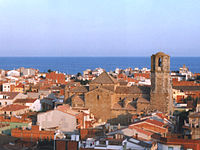Malgrat de Mar
| Malgrat de Mar | ||
|---|---|---|
| Municipality | ||

Malgrat de Mar in 1999
|
||
|
||
| Location in Catalonia | ||
| Coordinates: 41°39′N 2°45′E / 41.650°N 2.750°E | ||
| Country |
|
|
| Community |
|
|
| Province | Barcelona | |
| Comarca | Maresme | |
| Government | ||
| • Mayor | Joan Mercader Carbó (2015) | |
| Area | ||
| • Total | 8.8 km2 (3.4 sq mi) | |
| Elevation | 4 m (13 ft) | |
| Population (2014) | ||
| • Total | 18,417 | |
| • Density | 2,100/km2 (5,400/sq mi) | |
| Demonym(s) | Malgratenc | |
| Website | www |
|
Malgrat de Mar is a municipality in the comarca of the Maresme, in the province of Barcelona, Catalonia, Spain. It is situated on the coast between Santa Susanna and Blanes. A local road runs from the town to the main N-II road, while the B-682 connects it with Blanes, Lloret de Mar and Tossa de Mar. It is served by a RENFE railway station on the line between Barcelona and Maçanet-Massanes.
The town is located 4 meters above sea level. It has a coastal-Mediterranean climate, with smoothed temperatures almost over the whole year. The annual precipitation amount averaged over the last 18 years is about 650 mm.
Malgrat de Mar was first populated between the 13th and 14th centuries, when it was known as Vilanova de Palafolls. However, it is known that the early inhabitants of Malgrat built their houses on the hill (named "El Castell") that is located in the middle of the town.
Traditionally, Malgrat has been predominantly an agricultural town with considerable maritime commercial activity and, since the 19th Century, an important industrial centre. The tourist activity started in Malgrat de Mar around 1960. And since then it has become an important touristic destination.
...
Wikipedia



